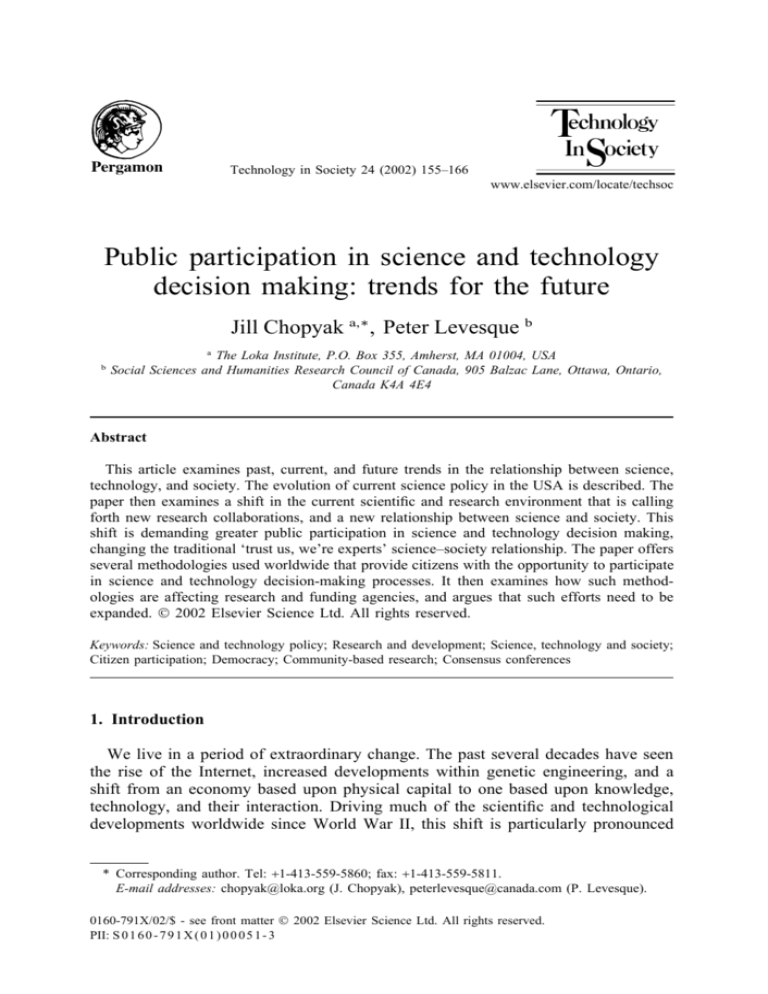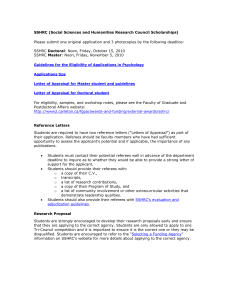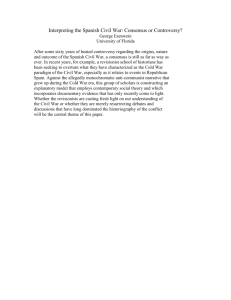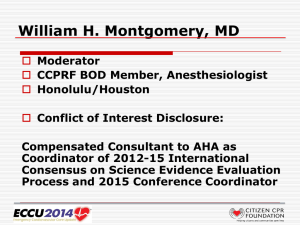
Technology in Society 24 (2002) 155–166
www.elsevier.com/locate/techsoc
Public participation in science and technology
decision making: trends for the future
Jill Chopyak a,∗, Peter Levesque b
b
a
The Loka Institute, P.O. Box 355, Amherst, MA 01004, USA
Social Sciences and Humanities Research Council of Canada, 905 Balzac Lane, Ottawa, Ontario,
Canada K4A 4E4
Abstract
This article examines past, current, and future trends in the relationship between science,
technology, and society. The evolution of current science policy in the USA is described. The
paper then examines a shift in the current scientific and research environment that is calling
forth new research collaborations, and a new relationship between science and society. This
shift is demanding greater public participation in science and technology decision making,
changing the traditional ‘trust us, we’re experts’ science–society relationship. The paper offers
several methodologies used worldwide that provide citizens with the opportunity to participate
in science and technology decision-making processes. It then examines how such methodologies are affecting research and funding agencies, and argues that such efforts need to be
expanded. 2002 Elsevier Science Ltd. All rights reserved.
Keywords: Science and technology policy; Research and development; Science, technology and society;
Citizen participation; Democracy; Community-based research; Consensus conferences
1. Introduction
We live in a period of extraordinary change. The past several decades have seen
the rise of the Internet, increased developments within genetic engineering, and a
shift from an economy based upon physical capital to one based upon knowledge,
technology, and their interaction. Driving much of the scientific and technological
developments worldwide since World War II, this shift is particularly pronounced
* Corresponding author. Tel: +1-413-559-5860; fax: +1-413-559-5811.
E-mail addresses: chopyak@loka.org (J. Chopyak), peterlevesque@canada.com (P. Levesque).
0160-791X/02/$ - see front matter 2002 Elsevier Science Ltd. All rights reserved.
PII: S 0 1 6 0 - 7 9 1 X ( 0 1 ) 0 0 0 5 1 - 3
156
J. Chopyak, P. Levesque / Technology in Society 24 (2002) 155–166
in the USA. A similar shift has occurred in the framework of science and technology
development and decision making. The ‘social contract’ between science and society
that emerged in the 1950s is undergoing a major shift with considerable implications
for science and technology policy worldwide.
This paper argues that a new framework for science and technology decision making is emerging that goes beyond the traditional triple helix of government–industry–
university, and that this framework has the potential for finding mutually beneficial
results for traditional and non-traditional players alike. The paper examines efforts
to expand science and technology decision making beyond the traditional players;
examines the interface between science and society in the USA, Canada, and Europe;
and discusses the current and future impact such efforts have on policy-making institutions worldwide.
2. Background
The traditional’ model for science and technology decision making worldwide
developed largely within the USA. In the first 25 years following World War II, the
USA dominated the world in scientific and technological advances [1]. Predominantly focused on defense and basic research, this model resulted in a relationship
between federal governments and university-based researchers—a relationship based
on an informal ‘social contract’ between science and society. Developed largely by
Vannevar Bush in his report to US President Franklin D. Roosevelt, entitled Science:
The Endless Frontier, the ‘contract’ recognizes the relationship between the federal
government and universities, and suggests that scientific and technological developments be exploited for commercial use as needed [2]. The contract also established
a tacit understanding that science and research would be free from government control or regulation.
Changes in the USA and increasing competitiveness from Europe and Japan in
the 1970s and 1980s shifted the trend, bringing the relationship between science,
technology, and industry into closer alignment. Until then, the primary role of the
US government in research and development (R&D) was funding. From 1953 to
1978, the US government funded 50–60% of total R&D in the USA. Half of this
was consistently spent on defense-related areas. Traditionally, this funding went to
academic researchers in universities and federally sponsored research institutions,
and to private and public laboratories. During this period, scientific and technological
developments were controlled largely by experts employed by these institutions, who
would transfer information and results to the public and commercial interests as needed.
The insular relationship between government and universities began to shift, in
large part due to increased international competition, in the late 1970s and early
1980s. Combined with allegations of scientific misconduct during the same period
[2], the sphere of influence around science and technology decision making opened
up to include industry. Legislation aimed at fostering innovation and technology
transfer from federal research agencies to industry also solidified the relationship with
J. Chopyak, P. Levesque / Technology in Society 24 (2002) 155–166
157
industry. The Stevenson–Wydler Technology Innovation Act of 1980, the Bayh–Dole
Patent and Trademark Amendments Act of 1980, and the Federal Technology Transfer Act of 1986 encouraged commercial technology transfer, and made it possible
for research developed in universities to be patented for commercial use. This spurred
unprecedented emphasis on industry-based research and development.
Beginning in 1978, commercial R&D funding began to supersede R&D funding
from the federal government, making the market and private sector the primary drivers of scientific and technological developments in the USA. Currently, US industry
R&D spending is two to three times the amount of federal spending. This trend is
consistent throughout OECD countries, as is seen in Table 1. This shift—as well as
the legislative incentives mentioned above—has made industry a more prominent
player in R&D.
3. Changes in research and development
The transformation in funding has significantly changed R&D methodology. The
successful application of knowledge is no longer simply a process question, but
rather the question for researchers is how to access available resources efficiently.
This shift is forcing researchers to come together across disciplines and across institutions in new and previously unforeseen ways:
For too long, commercialization has been understood largely in terms of the application and exploitation of existing knowledge. In the new competitive regime,
commercial success requires the ability to generate knowledge using resources
which are not stored in-house but distributed throughout a vast, and increasingly
global network…[firms] have to develop new types of links with universities,
government laboratories and other firms [3]
Examples of such collaborations abound in the science and technology field. SUN
Microsystems, now one of the world’s leading developers of computer networking
systems, was originally developed at Stanford University. In fact, the acronym SUN
Table 1
Sources of total and industry R&D performed in OECD countries, selected years
Year (%)
OECD total R&D
financed by:
1981
1986
1991
1997
Industry
Government
Other domestic
sources
51.2
45.0
2.5
54.1
42.0
2.4
58.7
35.8
3.4
62.3
31.4
3.8
158
J. Chopyak, P. Levesque / Technology in Society 24 (2002) 155–166
is derived from Stanford University Network. In another example, Novartis, the
Swiss pharmaceutical giant, recently funded the University of California at Berkeley
(to the tune of US$25 million) to conduct basic research in the Department of Plant
and Microbiology. In exchange for the funding, Novartis is given first right to negotiate licenses on one third of the department’s discoveries, whether those discoveries
were funded by Novartis or from government sources [4].
Such research collaborations are raising significant concerns about research ethics,
accountability, and conflicts of interest, as many researchers are turning their research
results into commercial interests for themselves and the university. This was highlighted with the 1999 death of 18-year-old Jesse Gelsinger, a gene-therapy patient
at the University of Pennsylvania where questions of conflict of interest were raised
during the investigation of the youth’s death.
New R&D collaborations are also raising issues about the role of universities,
what is meant by ‘researcher’ or ‘expert’, how knowledge is created, and who creates
it. Expanded educational opportunities have had a significant impact in moving
science and technology out of traditional institutions. Not only are more people educated at a graduate or postgraduate level, but highly educated researchers are choosing to work outside universities and federal research institutions. These experts are
moving into commercial areas, public-interest and non-governmental organizations.
The “massification of education”[3], and the movement of experts out of traditional
research institutions has developed a more informed and educated citizenry. The
ability to develop, create, and understand knowledge within the scientific and technological fields is no longer kept in the ‘ivory tower’, but is now also found in the
broader community.
Increased access to education, new methods of conducting research and development, unique collaborations, and recent scares and controversies in both the USA
and Europe (genetically modified foods, mad-cow and foot-and-mouth diseases) have
shifted the relationship between science and society. Scientists are now being held
to greater accountability by a variety of communities (both public and private), and
the idea that scientists should be trusted to work in the interest of the public good—
by virtue of their profession—is no longer accepted. This is causing government
leaders and policy makers worldwide to find ways of effectively communicating
science and technology issues to the public and to include citizens in science and
technology decision-making processes.
The idea of public participation in decision making is not new. Developing out
of public-interest movements during the 1960s and 1970s, participatory processes
were for the most part relegated to particular areas of society. The current trend of
public participation in science and technology has a new dimension and is much
more widespread. “What…may be said to be new’ is the thriving methodological
innovation, the wide practical application and the apparently increasing interest in,
and commitment to, public participation on the part of officialdom and the scientific
community”[5]. New methodologies for including the public in science and technology decision making have been developed and tested worldwide. They have
shown that citizen involvement results in better decisions and builds citizen and
community capacity.
J. Chopyak, P. Levesque / Technology in Society 24 (2002) 155–166
159
4. Current trends in public participation
Citizen input into science and technology decision making currently takes many
forms: community-based and participatory research, the Danish ‘consensus conference’, participatory urban planning, and community development and planning processes that use different scenarios to determine the best course of action (scenario
workshops).
4.1. Community-based research
Community-based research (CBR) is a collaborative partnership between
researcher and community. Turning the traditional research model on its head, CBR
is conducted by, or in participation with, the community that is affected by the
problem the research attempts to address. (’Community’ in this context is defined
as a group of people with like-minded interests, and can expand beyond geographical boundaries.)
Practitioners who challenged conventional top-down approaches to international
development pioneered CBR several decades ago. In the early 1970s, researchers—
primarily in Asia and Latin America—began to question the reductionism of most
research, and its inability to solve the myriad problems individuals were facing.
Working with oppressed communities, researchers began to collaborate with community members in designing and implementing research projects that had direct
relevance to their struggles.
The idea of CBR grew during the 1980s as those involved in international development grew increasingly frustrated with their inability to solve problems related to
community development, education, health, and poverty. Development practitioners
began to work closely with researchers and community members using participatory
research methods as a way of developing effective solutions to many of the problems
they were facing.
By 1997, the Fourth World Congress on Action Research in Colombia included
presentations on local and international CBR projects. For example, villagers from
Kenya, Cameroon, Nepal, Pakistan, Guatemala, and Colombia presented a collaborative project with researchers to strengthen community water management. The
Urban University and Neighborhood Network in the USA presented a project where
researchers from seven large cities in the state of Ohio, each with its own state
university, linked themselves with neighborhood-based organizing and development
groups in their cities.
Other participatory models developed during the 1980s and 1990s as the old social
contract for science began to break down. Another possible explanation for the rise
of public, non-governmental participation in research and science and technology
decision making is that all communities have more problems than resources to solve
them. Involving expertise or experience from universities or other sectors is a method
of leveraging intellectual and financial resources perhaps not otherwise available.
There are increasing numbers of success stories of how leveraging resources, knowledge, capacity, and history have resulted in mutually beneficial results for the
160
J. Chopyak, P. Levesque / Technology in Society 24 (2002) 155–166
majority of stakeholders in a project. The Loka Institute’s examination of CBR [6]
determined that this method of conducting research was not only cost effective but
produced positive ancillary results which were unintended but welcome. It improved
quality of life in communities, transferred results of research directly into policy
making and administrative procedures, and was directly responsive to citizen needs
and concerns. Furthermore it changes the fundamental nature of research by converting common research subjects into active research participants.
4.1.1. Example 1: CBR in Philadelphia
Residents in the Northern section of Philadelphia, Pennsylvania (USA) participated
in collecting information about lead-poisoning awareness in their neighborhood.
North Philadelphia is one of the city’s highest risk areas for lead poisoning, because
of the lead dust produced by lead-based paint in and on the area’s old and deteriorating housing. Forty-five percent of children tested in Philadelphia are estimated to
suffer from some degree of exposure to lead. And because many families in the area
do not have sufficient access to health care, children are being treated only on a
crisis basis and miss recommended health and development screenings. Because tenant council presidents of neighborhood apartments were part of the research team,
the team was able to reach a broader study sample, as well as design an effective
implementation strategy that included block parties, after-school and camp programs,
and cultural activities such as puppet shows and music shows that raised the awareness of neighborhood residents of the prevalence of lead in their homes. This has
resulted in a 27% increase in numbers of children tested for lead and a 10% reduction
in children with dangerous lead levels.
4.2. Danish Consensus Conference
In Denmark, the Danish Board of Technology has demonstrated how creating a
dialog with citizens about science and technology issues has resulted in better
decisions. Their consensus conference process allows citizens to make policy recommendations about specific scientific or technological developments, and those recommendations are then included in the process by which the Danish Parliament
makes its decisions. The consensus conference process brings together 12–15 citizens
to learn and deliberate about a complex science and technology issue. The lay panel
then hears from and cross-examines a panel of experts. This information is used by
the lay panel which develops a policy statement on the issue, which is presented to
policy makers and the general public [7].
The impact of the consensus conference process on policy decisions differs
depending on the social and political context in which it takes place. In the Danish
example, the process is supported and coordinated by the Danish Board of Technology, which reports directly to the Danish Parliament. In this context, the recommendations developed by the lay panel are directly fed into the decision-making
process. The first US consensus conference (or ‘Citizen’s Panel’) took place in 1997
in Boston, MA. Coordinated by the Loka Institute and supported by private foundations and universities, the process was not officially connected to a particular
J. Chopyak, P. Levesque / Technology in Society 24 (2002) 155–166
161
decision-making body (although there was considerable interest from both state and
federal legislatures). In that context, the conference had little direct impact on policy decisions1.
Although the policy impact of the process differs depending on the context, a
common impact is the empowerment of lay citizens. The consensus conference process has consistently demonstrated that when citizens are given relevant information,
they can make coherent and well-thought-out recommendations on complex science
and technology issues. A participant in the US Citizen’s Panel commented “We’re
not the kind of people you read about in history books…Here was our first chance
to shape our world”[8]. Furthermore, consensus conferences draw general attention
to the particular issue they are addressing, and bring the issue into public debate.
For example, a month following a Canadian consensus conference on biotechnology,
the national public radio began a week-long series on genetically modified foods
and a flurry of press on the issue followed [7]. As can been seen from the above
examples, consensus conferences have taken place worldwide2 on topics such as
gene therapy, traffic issues, telecommuting, and transportation. The ability of this
process to work in a variety of political, social, and cultural contexts is largely due
to its simplicity. It is also reflective of a growing development to include citizens
in the process of deciding their technological future.
4.2.1. Example 2: Australian Consensus Conference on Biotechnology
During the 1980s and 1990s, biotechnology was one of the main research agendas
of the Australian government. Yet, there had been little discussion on the issue within
the public domain. Consumer protests in the UK began to leak over to the Australian
activist community, and the Australian Consumers Association and the Australian
Science Museum decided to coordinate a consensus conference on the topic to
expand public debate on the issue. A range of government ministries provided funding for the conference.
Recruitment of participants was done through advertising in a random selection
of locations. Through an interview process, the 14-member lay panel was selected.
Results from the process were publicized extensively through the Australian Broadcasting Corporation and via the World Wide Web.
A few months following the conference, several policy initiatives were announced.
Many of these were closely aligned with the recommendations of the lay panel. Most
likely, the initiatives were already in discussion prior to the conference. Yet, the
process gave voice to public concerns (such as regulatory oversight) and contributed
towards pushing forward the decision-making process [7].
1
For more information about the first US Citizen’s Panel, see http://www.loka.org/pages/panel.htm.
For a comprehensive list of consensus conferences around the world, see http://www.loka.
org/pages/worldpanels.htm.
2
162
J. Chopyak, P. Levesque / Technology in Society 24 (2002) 155–166
4.3. Scenario workshops
Developed in the early 1990s, the scenario workshop process is a participatory
urban planning methodology that brings together key stakeholders to discuss and
evaluate the impact of multiple technological choices on a particular setting. The
process is based on four scenarios that describe the day in the life of a resident 20
years from now. Each scenario describes alternative ways of solving particular problems (such as energy, water, housing, and transportation). The scenarios are designed
as visions, not predictions. Stakeholders then come together for a weekend to develop
their own vision of the future, using ‘role play’ and the four scenarios as the basis
for discussion. The goal of the process is for participants to agree upon a vision and
articulate a set of action plans to achieve it [9].
The scenario workshop process requires significant preparation and planning.
Recruiting a diverse group of stakeholders to participate is key to the success of the
process. Its potential is to bring together local government, grassroots activists,
science and technology experts, and citizens to create a vision for their community.
It allows all groups to see different points of view and to deliberate about the technological choices a particular locale is making. Because of its complexity, the scenario
workshop process is not as widespread as the consensus conference, and its adoption
has been predominately within European settings. However, the Loka Institute and
the University of Massachusetts–Lowell have recently received funding from the
National Science Foundation to test the process in the USA.
4.4. Other public participation opportunities
There are other ways in which the public can be involved in research, science,
and technology decision making. The Precautionary Principle is an idea that has
been gaining recognition over the past 10 years. In January 1998, a group of US
activists and scientists gathered together to discuss the principle of precaution, and
came up with the ‘Wingspread Statement’ on the Precautionary Principle:
When an activity raises threats of harm to human health or the environment,
precautionary measures should be taken even if some cause and effect relationships are not fully established scientifically. In this context the proponent of an
activity, rather than the public, should bear the burden of proof…The process of
applying the Precautionary Principle must be open, informed and democratic and
must include potentially affected parties. It must also involve an examination of
the full range of alternatives, including no action [10]
The Principle itself calls for citizen participation (those potentially affected) in the
decision-making process. Applying the Principle to issues such as human genetic
testing, for example, would force us to examine alternatives to such testing. Increasing the range of options that such discoveries entail fosters greater innovation and
creativity in the scientific process, leading to better scientific decisions.
In the USA, the Jefferson Center has designed a wide range of processes (citizen
J. Chopyak, P. Levesque / Technology in Society 24 (2002) 155–166
163
juries, feedback panels, public participation workshops) that bring lay citizens into
decision-making processes. Although their focus is not on science and technology
issues exclusively, many of their models can be adapted to the science and technology realm3.
5. Implications for future science and technology policy
The processes outlined above are increasingly allowing citizens to take an active
part in science and technology decision-making processes. This trend is having an
impact on science and technology policy and funding at the federal level. In Canada,
for example, a range of programs and initiatives has been created and promoted
which support collaborative research projects and research-related programs between
citizen groups, universities, and policy-making agencies. Among the programs funding these initiatives are the Community–University Research Alliances Program [11],
the Community Alliances for Health Research Program [12], the Non-profit Sector
in Canada joint initiative between the Social Sciences and Humanities Research
Council of Canada (SSHRC) and the Kahanoff Foundation [13], various efforts by
the Rural Secretariat [14], and a diverse portfolio of programs through ministries
and agencies such at Environment Canada, Natural Resources Canada, Citizenship
and Immigration Canada, Status of Women Canada, and Heritage Canada.4 Other
organizations, agencies, and initiatives are attempting to map out needs, resources,
and gaps in capacity for engaging in collaborative research activities. These include
the Canadian Center for Philanthropy, the National Voluntary Organizations of Canada, and the National Roundtable on the Voluntary Sector. The Policy Research
Initiative of the Privy Council Office, one of the four central agencies of the Canadian
federal system, helps determine horizontal research priorities within the federal
bureaucracy. The theme chosen for their annual national research policy conference
for 2001 is ‘Bringing Communities Together’ [15]. This theme directly addresses
the existing gaps in knowledge, personnel, and capacity to adequately deal with the
myriad issues facing Canadian communities. It is also a recognition that solutions
cannot be delivered exclusively by elites in institutions but must be approached and
maintained as a collaborative enterprise with feedback loops to, between, and within
community-based organizations (CBOs) and other stakeholders.
In the USA, proportionately fewer government initiatives, but substantially more
private foundations and private civic entrepreneurship, are involved than in Canada.
The Aspen Institute has developed a comprehensive range of policy programs
encouraging multi-sector research including the Community Strategies Group,
Democracy and Citizenship Program, Justice and Society Program, Non-profit Sector
and Philanthropy Program, and the Roundtable on Comprehensive Community
3
For more information about the Jefferson Center and their activities, see http://www.jeffersoncenter.org/default.htm.
4
The complete listing of Canadian Government Departments and Agencies is available at:
http://www.canada.gc.ca/depts/major/depindFe.html#S.
164
J. Chopyak, P. Levesque / Technology in Society 24 (2002) 155–166
Initiatives [16]. National University in California has designated itself as a center
for civic entrepreneurship and is encouraging faculty to become directly involved in
the needs of communities.
The leading US federal agencies that fund similar-type partnerships are the US
Centers for Disease Control and Prevention (CDC) in Atlanta, Georgia, and the
National Institute of Environmental Health Sciences (NIEHS). The CDC maintains
programs which fund collaborative CBR in epidemiology, population health, disease
prevention, as well as system delivery and management [17]. Their Urban Research
Centers provide substantial funding for partnerships between scientists from CDC,
universities, and CBOs. This funding is focused on addressing the many social and
environmental determinants of health. The NIEHS supports university–community
collaborations with their Environmental Justice and Community-based Prevention
and Intervention Programs.
Private foundations such as the W.K. Kellogg Foundation, the C.S. Mott Foundation, the David and Lucille Packard Foundation, and the Carnegie Corporation are
also putting funds towards collaborative research and community-based decisionmaking processes. The Nathan Cummings Foundation recently funded the University
of New Hampshire to develop a series of consensus conferences on biotechnology
for the state of New Hampshire, and the National Science Foundation has also funded
a scenario workshop process in Massachusetts. US funding agencies are beginning
to recognize that the old model of ‘trust us, we’re experts’ is no longer acceptable
and are exploring collaborative relationships with communities.
The European Union (EU) is probably the most progressive government entity
promoting public participation and addressing the interface between science and
society. A recent Working Document by the European Commission comments on
this issue explicitly:
Modern science has developed on the basis of an unspoken ‘contract’ between
science and the institutions taking responsibility for it (universities, industry,
governments), on the one hand, and society and the public, on the other. New
relationships are needed that fit the new mould of science, technology and society
…There is a need to…create an open dialogue between researchers, industrialists,
policy makers, interest groups and the public as a whole [18].
As part of this effort, the EU recently funded a project to establish an international
network of science shops/community research centers—institutions and organizations
that conduct CBR in the public interest. The SCIPAS (Study and Conference for
Improving Public Access to Science) project brought together nine partners from the
Netherlands, Denmark, Israel, South Africa, Germany, Romania, the USA, Austria,
and Ireland. Funded under the EU’s Fifth Framework Program, the SCIPAS project
conducted research and analysis on trends in CBR/science shop activities, and established the initial framework for an international network. The project consortium
sponsored a conference ‘Living Knowledge: Bridging Public Access to Research’,
in Belgium, 25–27 January 2001, that brought together ca 120 interested individuals
J. Chopyak, P. Levesque / Technology in Society 24 (2002) 155–166
165
from 20 countries. Results from research projects were presented, and discussion
included resources and projects for an international network.
Mike Rogers from the European Commission’s Research Directorate General
summed up the project in this way: “Living Knowledge is not just about the dynamics
of the most valuable asset a society produces and that it flows to society as well as
to industry; it is also about the knowledge for living the kind of life society has the
right to shape for itself, in the context of today’s complex world.5
6. Conclusion
Scientific and technological developments have significant impacts on societies,
communities, and individual citizens. At the same time, the research and policy
environment in which scientists operate has undergone equally significant changes
over the last 50 years. Policy makers are struggling to keep up with the rapid development of new technologies and the impact these technologies have. Concurrently,
the decision-making framework for science and technology has dramatically shifted.
Commercial interests now have a considerable interest in research and development
decisions, and are the largest funders of R&D worldwide. These shifts impact the
way R&D is conducted as well as the interface point between research, science,
technology, and society. A well-educated and informed citizenry is calling for greater
accountability for science and technology decisions.
Many of the models discussed above reflect the shift in both the decision-making
sphere and the R&D environment. The idea of bringing citizens into science and
technology decision-making process, however, is not yet widely accepted. Stronger
efforts are needed to promote the benefits of these democratic methodologies at the
local, regional, national, and international levels. Additional research on the impact
of such methodologies on citizens, communities, experts, and policy-making processes is also needed at the national and international levels. Programs in public
and private funding institutions must recognize that the interface between science,
technology, and society is one of the most pressing issues of the 21st century.
References
[1] Office of Technology Policy, U.S. Department of Commerce, http://www.ta.doc.gov/CMSlides
[2] Guston D, 2000. Retiring the social contract for science. Issues Sci Technol, Summer http://
www.nap.edu/issues/16.4/p-guston.htm
[3] Gibbons M, Limoges C, Nowotny S, Schwartzman S, Scott P, Trow M. The new production of
knowledge. London: SAGE, 1994, p. 50.
[4] Washburn J. The kept university. Atlantic Monthly 2000;285(3):39–53.
[5] Joss S. Public participation in science and technology policy- and decision-making—ephemeral
phenomenon or lasting change. Sci Public Policy 1999;26(5):290–3.
5
For more information about the SCIPAS consortium and project, see http://www.bio.uu.nl/liviingknowledge.
166
J. Chopyak, P. Levesque / Technology in Society 24 (2002) 155–166
[6] Sclove R, Scammell M, Holland B. Community-based research in the U.S.: an introductory
reconnaissance. Amherst (MA): The Loka Institute, 1998.
[7] Einsiedel EF, Jelsoe E, Breck T. Publics at the technology table: the consensus conference in
Denmark, Canada and Australia. Public Understanding Sci 2001;10:1–16.
[8] Sclove R. Citizen policy wonks. Yes! A J. Positive Futures 1997;Fall:52–54.
[9] Andersen IE, Jaeger B. Scenario workshops and consensus conferences towards more democratic
decision-making. Sci Public Policy 1999;26(5):331–41.
[10] Montague P. The precautionary principle. Rachel’s Environ. Hlth Wkly No. 586
(http://www.sdearthtimes.com/et0398/et.398s4.html)
[11] Social Sciences and Humanities Research Council of Canada. Community–University Research
Alliances—a pilot program from SSHRC. In: SSHRC grants guide. Ottawa (Canada): SSHRC, 1999
http://www.sshrc.ca/english/programinfo/grantsguide/cura.html.
[12] Social Sciences and Humanities Research Council of Canada. Community Alliances for Health
Research (CAHRs). In: SSHRC grants guide. Ottawa (Canada): SSHRC, 1999 http://www.
sshrc.ca/english/programinfo/cahr.html.
[13] Social Sciences and Humanities Research Council of Canada. The non-profit sector in Canada, a
joint initiative of SSHRC and The Kahanoff Foundation. In: SSHRC grants guide. Ottawa (Canada):
SSHRC, 2000 http://www.sshrc.ca/englishj/programinfo/grantsguide/non-profit-sector.html.
[14] Agriculture and Agri-Food Canada. Rural secretariat. Ottawa (Canada) 2000.
http://aceis.agr.ca/policy/rural/rsmenue.html
[15] Policy Research Initiative, Privy Council Office. National policy research conference: bringing communities together. 2001 [http://policyresearch.schoolnet.ca/NationalConference/2001/whatnewe.htm]
[16] The
Aspen
Institute
Policy
Programs.
Washington,
DC.
Available
at:
http://www.aspeninstitute.org/policy/index.html
[17] Centers for Disease Control and Prevention. Grants and cooperative agreements. Atlanta (GA): Procurement and Grants Office, CDC 2000 http://www.cdc.gov/od/pgo/funding/grantmain.htm.
[18] Commission of European Communities, Commission working document: science, society and the
citizen in Europe, 14.11.2000 Brussels: Comission of European Communities, 2000 SEC (2000–
1973)
Jill Chopyak is the Executive Director of the Loka Institute, a national non-profit organization in Amherst,
MA (USA), working to bring a community voice into research, science, and technology decision making. Her
background is in international trade issues, sustainable agriculture, and international environmental policy.
Peter Levesque is the Programs Policy Officer at the Social Sciences and Humanities Research Council of
Canada, where he is involved in developing programs and policies bridging all disciplines in the social sciences
and humanities. He is a Board Member of the Loka Institute.








